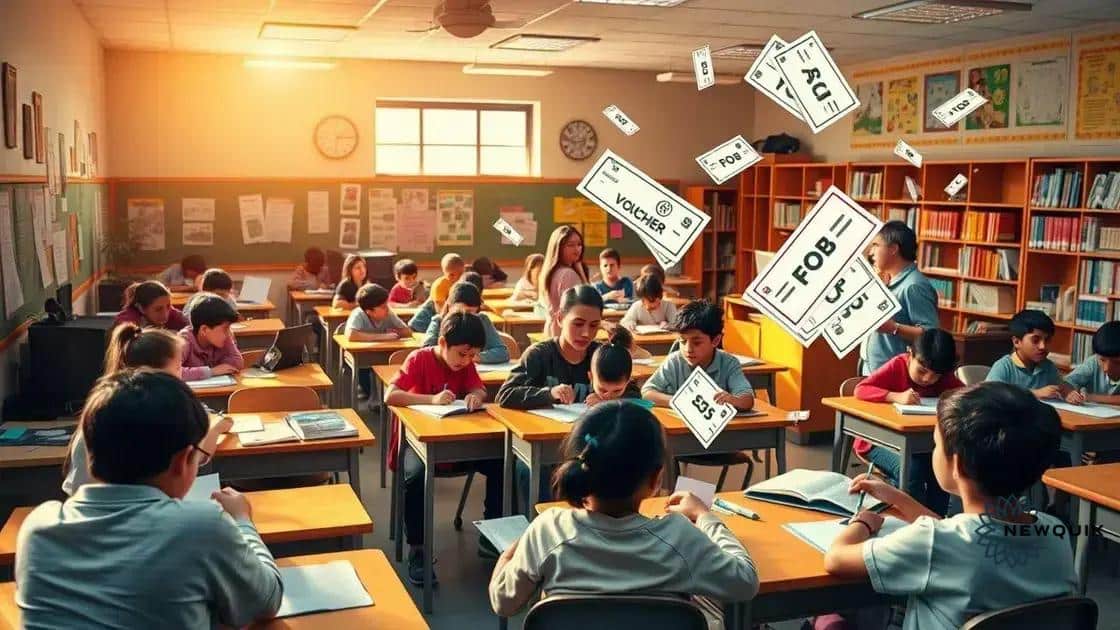Private school tuition vouchers introduced: a game changer

Private school tuition vouchers provide financial support for families, enabling them to choose quality educational options that better align with their children’s needs, while also promoting competition among schools.
Private school tuition vouchers introduced are sparking intense discussions among parents and educators alike. Have you considered how they could open doors to new educational opportunities for your children? Let’s explore what this means for families.
Understanding private school tuition vouchers
Understanding private school tuition vouchers is essential for families considering educational options for their children. These vouchers provide financial assistance to parents, allowing them to send their kids to private schools using public funding.
Vouchers are funded by the government, and they can vary in amount. This means that families may have access to significant help when it comes to private education. Let’s explore how these vouchers work.
How Do Tuition Vouchers Work?
Tuition vouchers are designed to give parents the freedom to choose the best educational setting for their children. When a family receives a voucher, they can use it to cover part or all of the tuition at a participating private school. Different states have different programs, so it’s crucial to research local options.
Key Features of Tuition Vouchers
- Financial aid for educational expenses.
- Offsets some or all tuition costs.
- Increases access to diverse educational environments.
- Encourages competition among schools.
Many parents appreciate having options outside of public schooling. With private school tuition vouchers, families can explore various schools that align with their values and educational philosophies. This flexibility can lead to improved student outcomes as schools strive to attract and retain students.
Moreover, it’s important to note that while some argue vouchers divert funds from public schools, others believe they can drive innovation and improvement across all types of educational institutions.
As more families learn about private school tuition vouchers, discussions around this topic will continue to shape educational policy and opportunities for students nationwide. Understanding the ins and outs can empower parents to make informed decisions about their children’s education.
Pros and cons of tuition vouchers
Pros and cons of tuition vouchers are often debated among educators, parents, and policymakers. Understanding these advantages and disadvantages can help families make informed choices about their education options.
One of the major benefits of tuition vouchers is that they provide financial support to families. This assistance makes it possible for parents to consider private schools that they might not otherwise be able to afford. Additionally, these vouchers can promote school choice, allowing families to select an educational environment that best fits their children’s needs.
Pros of Tuition Vouchers
- Increased access to quality education.
- Encouragement of competition among schools.
- More diverse educational options for families.
- Potential improvement in public school performance.
Despite these advantages, there are also some drawbacks to consider. One concern is that tuition vouchers may divert funds away from public schools, potentially weakening their resources and programs. Critics argue that this could lead to a disparity in educational quality.
Cons of Tuition Vouchers
- Possible reduction in funding for public schools.
- Limited availability of participating private schools.
- Criteria for acceptance may vary significantly.
- Public accountability may be less rigorous for private schools.
Another important factor to consider is the potential for inequality. Vouchers may not cover the full cost of tuition at more expensive private schools, which could leave low-income families unable to access the same opportunities as wealthier families. Moreover, not all parents are familiar with how to use their vouchers effectively, which can lead to confusion and underutilization.
As discussions around the pros and cons of tuition vouchers continue, it’s clear that both sides present valid points. Weighing these factors carefully can empower parents to make better choices regarding their children’s education.
How tuition vouchers impact public schools

How tuition vouchers impact public schools is a crucial topic to explore, as the introduction of these programs can create significant changes in the educational landscape. Many people are curious about how public schools adapt when families choose to use vouchers for private education.
One primary concern is the funding issue. When a student leaves a public school to attend a private institution using a voucher, the public school often loses a portion of its funding. This can lead to budget constraints, affecting resources available for other students.
Effects on Funding and Resources
As more students opt for private schools, public schools may need to adjust their budgets accordingly. This situation can result in:
- Teacher layoffs.
- Larger class sizes.
- Cutbacks on extracurricular programs.
- Reduced access to educational materials and technology.
Another aspect to consider is how public schools strive to improve their offerings in response to the competition created by tuition vouchers. Schools may work harder to enhance their academic programs and offer additional activities to attract and retain students.
Competition and Innovation
This competition can lead to positive changes in public schools, such as:
- Improved student performance.
- Innovative teaching methods.
- Better engagement with parents and the community.
- Increased transparency in school performance.
Yet, some critics argue that the pressure from vouchers can push public schools into a narrow focus on standardized test scores, rather than providing a well-rounded education. This approach could overlook other critical areas such as social-emotional learning and creativity.
Moreover, the presence of tuition vouchers can lead to concerns regarding equity. Families in wealthier areas may have greater access to private schools, whereas lower-income families might not have the same options. This disparity raises questions about whether all students are receiving equal opportunities for success.
As school systems evolve in the face of tuition vouchers, the long-term impacts remain a topic of ongoing exploration and debate. Understanding these dynamics is crucial for parents, educators, and policymakers alike.
Success stories from voucher programs
Success stories from voucher programs highlight the positive outcomes that families can experience when they utilize these educational tools. Many parents have found that vouchers can unlock access to high-quality education that better meets their children’s needs.
In several cities, schools participating in voucher programs have reported increased student performance. Families often share their excitement about how their children thrive in environments that align with their learning styles. For example, some parents have noted improvements in grades and overall engagement with schoolwork after their children switched to private institutions.
Real-world Examples
Here are some inspiring success stories:
- A family in Milwaukee used vouchers to enroll their son in a private school focused on STEM education. He went from struggling in public school to excelling in math and science.
- In Florida, a single mother credits the state’s voucher program for enabling her daughter to attend a top-rated private school. The girl’s confidence and academic performance have soared since the switch.
- Another family in Ohio reported that their son, previously diagnosed with learning disabilities, found support and success in a specialized private school that emphasizes individualized learning plans.
These stories illustrate how tuition vouchers can significantly impact students’ lives. Families often feel empowered when they choose schools that cater to their children’s unique needs. This choice creates a sense of hope and opportunity, particularly in cases where public schools may not have been able to provide the desired resources.
In addition to academic successes, many students develop new interests and skills after joining private schools. Activities such as music, art, and sports may be more available, providing children with a well-rounded educational experience. Parents frequently express gratitude for the opportunities that vouchers have opened up for their children.
Despite the ongoing debates surrounding the voucher system, these success stories remind us of the potential benefits. For many families, vouchers are not just funding mechanisms; they symbolize a pathway to brighter futures for their children.
Navigating the application process for vouchers
Navigating the application process for vouchers can seem overwhelming, but understanding the steps involved helps families make informed decisions. The process may vary by state or program, but several common elements exist across many voucher systems.
The first step for families is to research what types of vouchers are available in their area. Parents can visit local education websites or talk to school counselors for detailed information. This knowledge enables them to identify the best options suited to their children’s needs.
Understanding Requirements
Each program has specific eligibility requirements that families must meet. These often include:
- Proof of residency in the state or district.
- Income level assessments.
- Documentation of previous school enrollment.
- Age requirements for program participation.
After identifying eligible programs, families can prepare their applications. It is crucial to gather all necessary documents beforehand to avoid delays. Attention to detail is essential, as incomplete applications may be rejected.
Submitting Applications
Once the application is ready, parents should pay close attention to deadlines. Each voucher program will have specific submission dates. Submitting an application on time is often critical to securing a spot in a desired program.
Some programs require families to apply online, while others may accept paper applications. Families should follow the given instructions carefully. After submission, they may receive a confirmation email or message, which is always helpful to keep for tracking purposes.
Additionally, after applying, many families find themselves waiting for responses, which can be nerve-wracking. During this time, staying in touch with program representatives can provide updates and necessary guidance. Parents can also begin researching potential schools to understand better where they might want to send their children if accepted.
Ultimately, navigating the application process for tuition vouchers requires diligence and patience. Each family’s path may look different, but knowing the steps can help streamline the journey toward educational opportunities.
FAQ – Frequently Asked Questions about Private School Tuition Vouchers
What are private school tuition vouchers?
Private school tuition vouchers are government-funded financial aids that help families pay for private school tuition, allowing for more educational choices.
How can I apply for a tuition voucher?
To apply for a tuition voucher, families typically need to research local programs, gather required documentation, and submit an application by the specified deadline.
What are the benefits of using a tuition voucher?
Using a tuition voucher can provide families access to quality education, enhance student learning experiences, and promote competition among schools.
Are there any drawbacks to tuition vouchers?
Yes, potential drawbacks include the diversion of funds from public schools, inequality in access to private education, and application complexities for some families.





